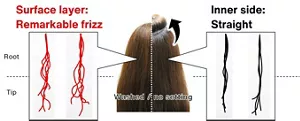Research on Hair Frizz Caused by Ultraviolet Rays
Hair Science
Frizz is one of the most serious hair problems. It not only disrupts uniform hair alignment and appearance, but also affects the texture of the hair, making it feel dry and stiff.
Through careful observation, Kao has discovered that frizz is more remarkable in surface layer than in inner layer, especially when backside hair is lifted (Figure 1). The frizz located in surface layer is often expressed as “flyaway,” and can be a common source of anxiety in our daily lives.
In this research, we analyzed hair in various aspects to investigate the mechanism behind frizz formation.
We focused particularly on the combined effect of ultraviolet (UV) rays and external forces (such as deformation caused by friction with a pillow), which primarily affects the surface layer. Utilizing spectroscopy and X-ray scattering, our analyses revealed that UV rays break disulfide bonds (S–S bonds) in hair proteins, and then some of the cleaved bonds recombine in a distorted manner due to external forces (Figure 2).
This suggests that irregularly shaped hair can be memorized, which leads to frizz formation through a similar mechanism to hair perms*1 .
Based on these findings, Kao aims to raise awareness on the importance of UV care for hair and also develop user-friendly and effective UV care products designed not only for skin but also for hair.
-
* 1 Tamura, T. (2024). Hair Frizz Caused by the Combined Effect of Ultraviolet Rays and External Forces and Development of Sunscreen for Hair. SPring-8/SACLA Information, 29(1), 2-5.

Figure 1

Figure 2
- Home
- Innovation
- Research & Development
- Fundamental Research
- Analytical Science
- Research on Hair Frizz Caused by Ultraviolet Rays
- Home
- Innovation
- Research & Development
- Fundamental Research
- Analytical Science
- Research on Hair Frizz Caused by Ultraviolet Rays
